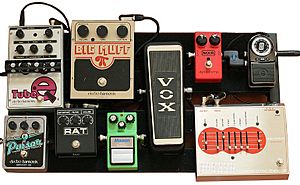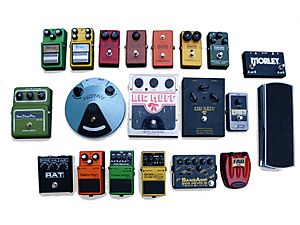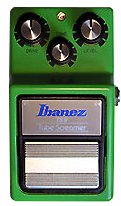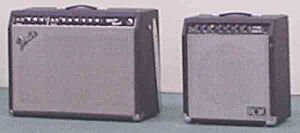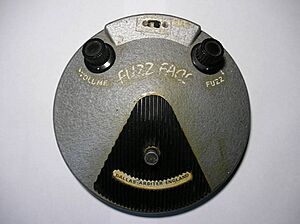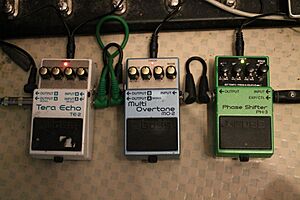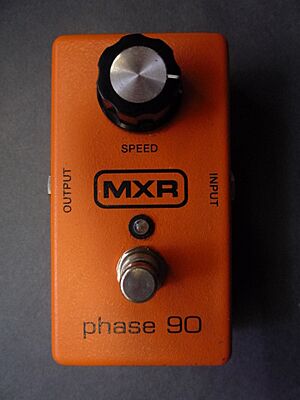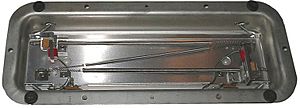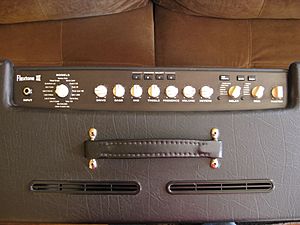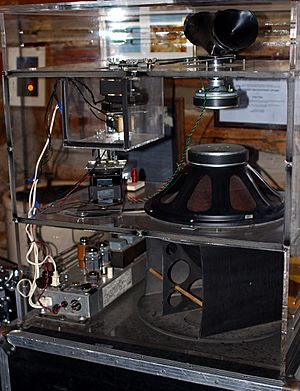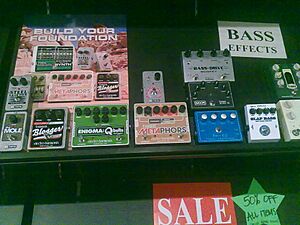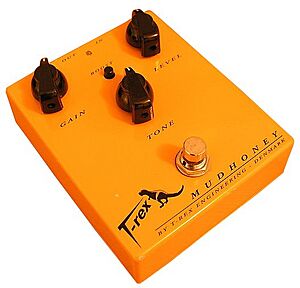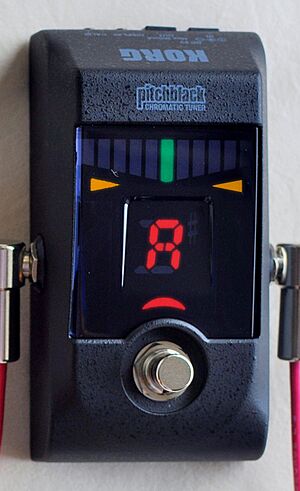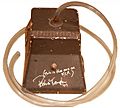Effects unit facts for kids
An effects unit or effects pedal is an electronic device. It changes the sound of a musical instrument. It can also change other audio sounds. Think of it like a special sound filter.
These effects can make many different sounds. Some add a rough, "distorted" sound. This is popular in rock music. Others change how loud the sound is. Some filters change the sound's tone. Modulation effects make sounds swirl or wobble. Pitch effects change how high or low a note is. Time effects create echoes or make sounds seem like they are in a big room.
Most modern effects use small electronic parts. Some older ones use tubes or mechanical parts. Effects are often used as stompboxes. These sit on the floor. Musicians turn them on and off with their feet. Effects can also be built into guitar amps. They can be in instruments like organs. Some are tabletop units for DJs. Others are large rackmount units. Many are also computer programs called audio plug-ins.
Musicians, sound engineers, and producers use effects. They use them for live shows or in the studio. Electric guitars, bass guitars, and keyboards often use them. But effects can be used with any sound. This includes acoustic instruments, drums, and even voices.
Contents
What Are Effects Called?
An effects unit has many names. People call it an effect box or effects processor. Sometimes it's just called an effect. You might see F/X or FX. A pedal on the floor is a stomp box or effects pedal.
When sound goes into an effect, it's called dry. After the effect changes it, it's called wet.
Musicians with many pedals often put them on a guitar pedalboard. This makes setting up faster. It also protects the pedals when traveling. If a musician has many effects in a rack, it's called an effects rack or rig. This also helps with quick setup.
Different Types of Effects Units
Effects units come in different shapes and sizes. Stompboxes are used for shows and recording. Rackmount devices were very popular in the past. They had strong sound processing. Now, digital computer plugins and better stompboxes are common. So, rackmount units are used less often. Effects units can be analog (older style) or digital (newer style). They can also be a mix of both.
Stompboxes: Foot-Controlled Fun
Stompboxes are small boxes. They are usually made of plastic or metal. Musicians place them on the floor. They use their feet to turn them on or off. Most stompboxes are rectangle-shaped. But some are round or other shapes.
A simple stompbox has one footswitch. It usually has one to three knobs. These knobs control the effect. A small light (LED) shows if the effect is on. For example, a distortion pedal might have knobs for how much distortion, the tone, and the volume. For a chorus effect, the knobs might control the depth and speed.
More complex stompboxes have many footswitches and knobs. They might have extra buttons you push with your fingers. Some have a small screen to show settings.

An effects chain is made by connecting two or more stompboxes. This chain is usually between the guitar and the amplifier. When a pedal is off, the sound signal goes around it. This is called a bypass. It means the sound is not changed by that pedal. This way, musicians can use many effects together. They don't have to unplug and replug pedals.
A controller helps musicians choose different effect chains. They can tap one switch to pick a whole group of effects.
It's common to put certain effects first. These include compression, wah, and overdrive pedals. Modulation effects like chorus or flanger go in the middle. Time-based effects like delay and reverb go at the end. Using many effects can sometimes add unwanted noise. Some musicians use a noise gate pedal. This helps reduce hum or static from other effects.
Rackmounts: Big Studio Power
Rackmount effects units are usually thin metal boxes. They have "rack ears" to screw into a special rack. These racks are standard in the music industry. Rackmount effects are 19 inches wide. Their height is measured in "rack units."
A rackmount unit might have the same circuits as a stompbox. But they are usually more complex. Unlike stompboxes, rackmounts often have many different effects in one unit. You control them with knobs and buttons on the front. You can also control them remotely. This is often done with a MIDI foot controller.
Rackmount effects are most common in recording studios. They are also used for live sound mixing. Musicians might use them instead of stompboxes. Racks can hold other gear too. Rackmount units are often put in a "road case." This case protects the equipment during travel.
Multi-Effects and Tabletop Units
A multi-effects (MFX) device is one unit with many electronic effects. It can be a pedal or a rackmount. Multi-effects units let users save combinations of effects. This helps musicians quickly change sounds on stage. They usually have distortion, chorus, flanger, phaser, delay, looper, and reverb.
Pedal-style multi-effects can be simple and cheap. Or they can be large and expensive. Rack-mounted multi-effects units can be in the same rack as amps.
A tabletop unit is a multi-effects device that sits on a desk. You control it with your hands. The Pod guitar amp modeler is an example. DJs often use digital effects in tabletop models. They place them next to their mixer and turntables.
Built-in Units: Effects in Your Gear
Effects are often part of instrument amplifiers. Some instruments even have them built-in. Electric guitar amps usually have reverb, chorus, and distortion. Acoustic guitar and keyboard amps often only have reverb. Some acoustic amps have reverb, chorus, compression, and EQ (bass and treble).
Older guitar amps often had tremolo and vibrato effects. They sometimes had reverb too. Built-in effects might offer less control. For example, some bass amps have a simple on/off button for compression. A separate pedal would give you more control.
Some guitar amps have built-in multi-effects. They can also have digital amp modeling. Bass amps are less likely to have built-in effects. But some have a compressor or fuzz bass effect.
Instruments with built-in effects include Hammond organs, electronic organs, and synthesizers. These effects often include reverb and chorus. Many digital organs have an overdrive effect. Sometimes, acoustic-electric and electric guitars have built-in preamps or equalizers.
History of Effects
Early Studio and Stand-Alone Effects
The first sound effects were used only in studios. Microphones in special "echo chambers" made sounds like live performances. In the 1940s, engineers like Les Paul used tape recorders. They created echo and futuristic sounds.
In 1948, DeArmond made the Trem-Trol. This was the first stand-alone effects unit. It made a tremolo sound. Most early stand-alone effects were expensive and big. They needed large parts and high power. Many effects were already built into amps, so stand-alone units weren't very popular.
The first popular stand-alone unit was the 1958 Watkins Copicat. It was a portable tape echo effect. The British band, The Shadows, made it famous.
Amplifiers and Their Sounds
Effects built into tube guitar amplifiers were the first ones musicians used often. From the late 1940s, Gibson added vibrato to their amps. The 1950 Ray Butts EchoSonic amp had a tape echo. Guitarists like Chet Atkins loved it. Both Premier and Gibson made amps with spring reverb. Fender started making tremolo amps in the mid-1950s.
Distortion was not planned by amp makers. It happened when early tube amps were played too loud. In the 1950s, guitarists started doing this on purpose. They wanted a "warm" distorted sound. Musicians like Willie Johnson and Chuck Berry experimented with distortion.
In 1954, Pat Hare made very distorted sounds. He turned his amp volume all the way up. Link Wray's 1958 song "Rumble" inspired many young musicians. They wanted to explore distortion. These included Pete Townshend, Jimmy Page, and Neil Young. In 1966, Marshall Amplification started making amps. These amps could create the distorted "crunch" sound rock musicians wanted.
The Rise of Stompboxes
The electronic transistor made stompboxes possible. Transistors were smaller and more stable than tubes. The first transistor guitar effect was the 1962 Maestro Fuzz Tone pedal. It became very popular after The Rolling Stones used it in their 1965 hit " (I Can't Get No) Satisfaction".
Warwick Electronics made the first wah-wah pedal in 1967. That same year, Roger Mayer made the first octave effect. Jimi Hendrix called it "Octavio." Hendrix used it on "Purple Haze" and "Fire." In 1968, Univox sold the Shin-ei's Uni-Vibe pedal. This pedal copied the sound of Leslie rotating speakers. Jimi Hendrix and Robin Trower loved it.
In 1976, Boss Corporation released the CE-1 Chorus Ensemble. This was the first chorus pedal. By the mid-1970s, many solid-state pedals were available. These included flangers, chorus, and phasers.
In the 1980s, digital rackmount units became popular. Musicians often recorded "dry" tracks. Effects were added later. But Nirvana's 1991 album Nevermind brought back interest in stompboxes. Some grunge guitarists used many fuzz pedals. They plugged them into tube amps. Throughout the 1990s, musicians like J Mascis and Stephen Malkmus kept using analog effects pedals.
Effects and stompboxes have been celebrated in music. The Big Muff fuzzbox is in a Depeche Mode song. It's also in a Mudhoney album title. Many other musicians have mentioned effects in their songs.
Types of Effects
Distortion: The Gritty Sound
Distortion, overdrive, and fuzz effects make sounds "warm," "gritty," or "fuzzy." They do this by changing the sound wave. They flatten its peaks. This adds new sounds called harmonics. Distortion effects are sometimes called gain effects. This is because distorted guitar sounds first came from turning up tube amps.
Distortion effects make perfectly flat peaks. This is "hard" clipping. Overdrive effects make a softer, tube-like distortion. They compress the sound wave without flattening it completely. Overdrive pedals can make clean sounds at low volumes. They make warm, distorted sounds at higher volumes.
Famous distortion pedals include the Boss DS-1 Distortion and Ibanez Tube Screamer.
A fuzz pedal makes a heavily distorted or "fuzzy" sound. It makes the sound wave almost a square wave. The Rolling Stones' song " (I Can't Get No) Satisfaction" made fuzz effects very popular. Fuzz bass is a style of playing bass. It uses fuzz or overdrive pedals to make a buzzy sound.
Famous fuzz pedals include the Arbiter Fuzz Face and Electro-Harmonix Big Muff.
Distortion effects are mostly used with electric and bass guitar. But they are also used on keyboards, drums, and vocals.
Dynamics: Controlling Volume
Dynamics effects change the volume of an instrument. They were some of the first effects for guitarists.
- Boost/Volume Pedal: A boost pedal makes an instrument louder. It increases the sound signal. These are used to make solos louder. They also prevent sound loss in long effects chains. A guitarist might use a boost to make their solo stand out.
- Treadle-based volume pedals let musicians change volume with their foot. This is useful when their hands are busy playing. They can also create "swelling" effects. The sound starts soft and gets louder. This copies how an orchestra's string section sounds. Volume pedals usually don't need batteries.
- Famous volume effects: Electro-Harmonix LPB-1, Ernie Ball Volume Pedal.
- Compressor: Compressors make loud sounds quieter. They make quiet sounds louder. They "compress" the sound's volume range. A compressor helps keep the volume steady. It can also make a note's attack smoother. It dampens the start and makes the sustain longer. A compressor can also act as a "limiter" with extreme settings.
- Famous compressor effects: Keeley Compressor, MXR Dyna Comp.
- Noise Gate: Noise gates reduce hum, hiss, and static. They make the volume very low when the sound signal drops below a certain level. Guitarists who use old amps or high distortion often use noise gates. This is because these can add noise even when no notes are played. Noise gates mute the sound when it's too quiet. This means the audience won't hear hum during quiet parts of a song. Noise gates are "expanders." They make quiet sounds even quieter.
- Famous noise gate effects: Boss NS-2 Noise Suppressor.
Filter: Shaping the Tone
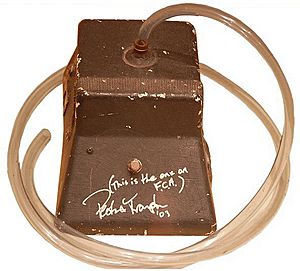
Filter effects change the sound's frequency content. They either make specific frequencies louder or quieter.
- Equalizer (EQ): An equalizer is a set of filters. They make certain sound frequencies stronger or weaker. Simple home stereos have EQ for bass and treble. Professional EQs offer much more control. Sound engineers use EQs to remove unwanted sounds. They can make an instrument or voice stand out. They also enhance parts of an instrument's tone.
- Famous EQ effects: Boss GE-7 Equalizer, MXR 10-band EQ Pedal.
- Talk Box: A talk box sends sound from a guitar or synthesizer into a tube. The tube goes into the musician's mouth. The musician shapes the sound into vowels and consonants with their mouth. A microphone picks up this changed sound. This makes the guitar sound like it's "talking." Famous songs using a talk box include Bon Jovi's "Livin' on a Prayer" and Peter Frampton's "Show Me the Way."
- Famous talk boxes: Dunlop HT1 Heil Talk Box.
- Wah-wah: A wah-wah pedal makes vowel-like sounds. It changes how loud the sound is at different frequencies. This is called a "spectral glide." A foot pedal operates it. Wah-wah pedals are popular with funk and rock guitarists.
- Famous wah effects: Dunlop Cry Baby, Morley Power Wah.
- Auto-wah: This filter effect is controlled by the input sound's volume. It's often a low-pass filter. Many pedals also offer band-pass or high-pass filters. Most auto-wah pedals can switch between "down" and "up" filter modes. This effect is common in funk, reggae, and jam band music.
- Famous auto-wah effects: Musitronics Mu-Tron III, Electro-Harmonix Q-Tron Plus.
Modulation: Adding Movement
Modulation means changing a signal's strength over time. In audio, it changes sound properties. Some modulation effects mix the instrument's sound with a sound created by the effect. Others split the instrument's sound in two. They change one part and mix it back with the original.
- Chorus: Chorus pedals copy the sound of choirs or string orchestras. These groups have slight differences in sound and pitch. A chorus effect splits the sound signal. It adds a small delay and pitch changes to one part. The rest of the signal stays the same. A famous use of chorus is the guitar in "Come As You Are" by Nirvana.
- Famous chorus effects: Boss CE-1 Chorus Ensemble, Electro-Harmonix Small Clone.
- Flanger: A flanger makes a "whooshing" or "jet plane" sound. It copies an old studio trick. This trick involved two tape recorders. Flanger units add a delayed version of the sound to the original. This creates a special filter effect. Famous flanger uses include "Walking on the Moon" by The Police and "Barracuda" by Heart.
- Famous flanger effects: Electro-Harmonix Electric Mistress, MXR Flanger.
- Phaser: A phaser or "phase shifter" creates a slight rippling sound. It makes some parts of the tone louder and others quieter. It does this by splitting the sound signal. It changes the "phase" of one part. Famous phaser uses include the guitar in Van Halen's "Eruption" and keyboards in Billy Joel's "Just the Way You Are."
- Famous phaser effects: Uni-Vibe, MXR Phase 90.
- Ring Modulator: A ring modulator makes a metallic, resonant sound. It mixes the instrument's sound with a sound from its own internal oscillator. The original sound is removed. It's replaced by new, unusual pitches. A notable use is the guitar in the Black Sabbath song "Paranoid."
- Famous ring modulator effects: Moogerfooger MF-102 Ring Modulator.
- Tremolo: A tremolo effect makes a slight, rapid change in volume. This is different from a "tremolo bar" on a guitar. That bar changes pitch. In electronic effects, tremolo is made by changing the sound wave's volume. Tremolo effects are built into some old guitar amps. The guitar intro in the Rolling Stones' "Gimme Shelter" uses tremolo.
- Famous tremolo effects: Demeter TRM-1 Tremulator, Fender Tremolux.
- Slicer: This effect combines modulation with a noise gate or envelope filter. It creates a percussive, rhythmic sound. It can sound like a helicopter.
- Vibrato: Vibrato effects make slight, rapid changes in pitch. This copies how singers or violinists naturally change pitch. Vibrato effects often let you control the speed and depth of the change. A deep vibrato can make a dramatic, wobbly sound. In electronic effects, vibrato is made by changing the sound wave's frequency. Guitarists often mix up "vibrato" and "tremolo." A "vibrato unit" in an amp actually makes tremolo. A "tremolo arm" on a guitar makes vibrato.
- Famous vibrato effects: Boss VB-2 Vibrato.
Pitch/Frequency: Changing Notes
Pitch/frequency effects change the pitch of a sound. They do this by changing its frequency. Or they add new harmonies.
- Pitch Shifter and Harmonizer: A pitch shifter (or "octaver") raises or lowers each note you play. It changes the pitch by a set amount. For example, a pitch shifter set to a fourth will raise each note four steps. Simple pitch shifters change the pitch by one or two octaves. More advanced ones offer many different changes. A guitarist can use a pitch shifter to play notes usually only found on a bass. A bass player can use an octave pedal to get very low notes.
A harmonizer is a type of pitch shifter. It mixes the changed pitch with the original pitch. This creates a two-note harmony. Some can even create three-note harmonies. Some harmonizers can also make chorus-like effects.
- Famous pitch shift effects: DigiTech Whammy, Electro-Harmonix POG.
Time-Based: Echoes and Loops
Time-based effects delay the sound. They add reverb or echoes. If the delay is long, musicians can record "loops." 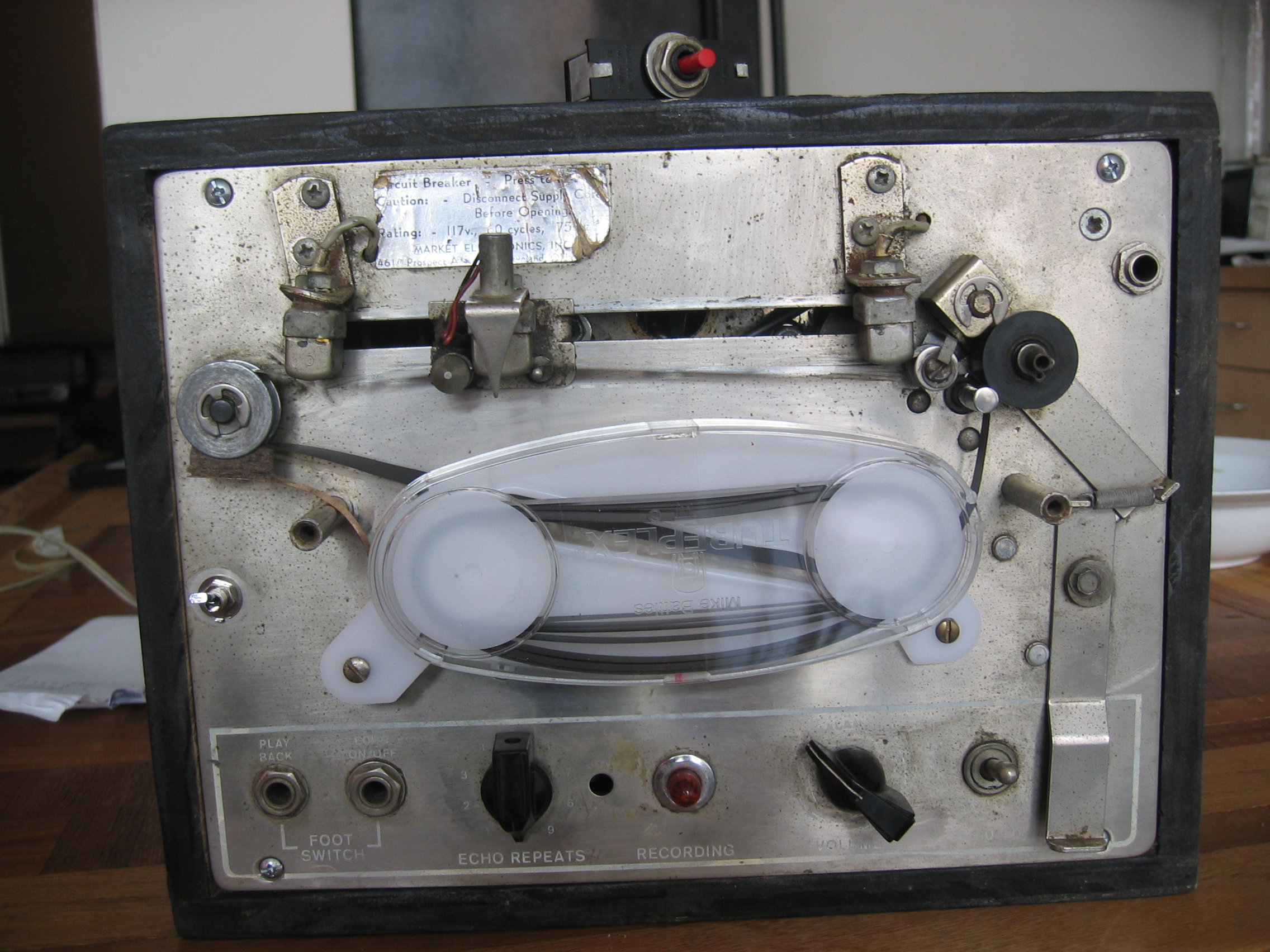
- Delay/Echo: Delay/echo units create an echo sound. They add a copy of the sound signal to the original. This copy is slightly delayed. The effect can be a single echo ("slapback") or many echoes. A famous use of delay is the guitar in the U2 song "Where the Streets Have No Name." It's also in the intro to "Welcome to the Jungle" by Guns N' Roses.
- Famous delay effects: Boss DD-3 Digital Delay, MXR Carbon Copy.
- Looper Pedal: A looper pedal lets a musician record a phrase or riff. They can then play it back later. Loops can be made during a live show. Or they can be pre-recorded. A singer-guitarist can play chords, loop them, and then sing and play a solo over them. Some units let you layer many loops. This makes it sound like a full band. Early loop effects used tape. Modern ones use electronic memory.
- Reverb: Reverb units copy the spacious sounds of a big hall or cathedral. They do this by creating many echoes. These echoes slowly fade away. One old way to make reverb was to play music in a tiled room. Then, they recorded the natural echoes. A plate reverb uses a metal plate to create vibrations. Spring reverb systems use a spring. These are often in guitar amps. Digital reverb effects use computer programs. They create the reverb sound with many delay circuits. Rockabilly and surf guitar use a lot of reverb.
- Famous reverb effects: Electro-Harmonix Holy Grail, Fender Reverb Unit.
Feedback/Sustain: Holding Notes Longer
- Audio Feedback: Audio feedback happens when amplified sound is picked up by a microphone or guitar pickup. It then plays back through the amp. This creates a high-pitched sound. Usually, feedback from a vocal mic is avoided. But in rock music, guitarists create feedback on purpose. They play their guitar in front of a loud, distorted amp. This makes long, high-pitched sounds. Jimi Hendrix was a pioneer in using feedback creatively. It can be hard to control. Guitar feedback is used in psychedelic rock, heavy metal, and punk rock.
- EBow: The EBow is a small, handheld, battery-powered device. It makes a note on an electric guitar string ring continuously. It sounds like a bowed violin or a sustained organ note. It uses magnets and coils to make the string vibrate. The EBow only works on one string at a time. Later EBow models have a switch. This lets you choose between just sustain or adding overtones.
Many compressor pedals are also called "sustainer pedals." When a note is held, it loses volume. A compressor pedal boosts its signal. This makes the note last longer. Combined with distortion and a loud amp, this can create endless sustain.
Other Cool Effects
- Envelope Follower: An envelope follower turns on an effect when the sound reaches a certain volume. The auto-wah is an example. It makes a "wah" sound based on how loud or soft you play.
- Guitar Amplifier Modeling: Amp modeling is a digital effect. It copies the sound of different amplifiers. It often imitates old tube amps and famous speaker cabinets. Advanced modeling can even copy different speaker sizes. It can also copy how microphones are placed. A rotary speaker simulator copies the sound of a Leslie speaker system. It makes volume and pitch changes, distortion, and phase shifts.
- Pitch Correction/Vocal Effects: Pitch correction effects use computer programs. They fix wrong notes in a singer's performance. Or they create unusual vocal effects. Autotune is a well-known example. It can fix pitch or add vocal effects. Some vocal pedals have multiple effects like reverb and pitch correction.
- Simulators: Simulators let electric guitars sound like other instruments. These can be acoustic guitars, electric basses, or even sitars. Pickup simulators make a guitar with one type of pickup sound like another. A "de-fretter" is a bass guitar effect. It makes a fretted bass sound like a fretless bass.
- Bitcrusher Filters: Bitcrushers turn sound into a digital format. Then they reduce the sound quality. This adds a unique, "crushed" sound.
- Rotating Speakers: Rotating speakers are special amps or loudspeakers. They create unique sounds using the Doppler effect. They rotate the speakers or a sound-directing part. This creates a chorus-like effect. They are named after Donald Leslie. They are often used with the Hammond organ. But they are also used with other instruments and vocals. The Uni-Vibe pedal simulates this effect.
- Korg Kaoss Pad: The Korg Kaoss Pad is a small touchpad device. It's a controller, sampler, and effects processor. You use the touchpad to control its effects. These can be applied to live sound or recorded samples. Effects include pitch shifting, distortion, filtering, wah-wah, tremolo, flanging, delay, reverb, and more. It can also be used as a MIDI controller.
Bass Effects
Bass effects are made for the low sounds of an electric bass. Or for an upright bass used with an amp. Fuzz bass and bass chorus are two examples. Some bass amplifiers have built-in effects. These might be overdrive or chorus. Upright bassists might use a bass preamplifier. This small device helps connect their pickup to the amp. Bass preamps can also boost or cut the signal. Some have EQ controls, a compressor, and a DI box connection.
Boutique Pedals: Special and Unique
Boutique pedals are made by smaller, independent companies. They are usually made in limited numbers. Some are even handmade. These pedals are often sold online or in a few music stores. They are usually more expensive than mass-produced pedals. But they often have higher-quality parts and unique designs. Some boutique companies focus on making copies of classic or vintage effects.
Some boutique pedal makers include Robert Keeley and Strymon.
Modifying Pedals
There's also a market for changing or "modding" effects. People offer custom changes or sell already modified pedals. The Ibanez Tube Screamer and Boss DS-1 are often modified. Common changes include swapping parts for better ones. They might add "true-bypass." This means the effect's circuit is completely out of the sound path when off. Or they might add new functions.
Other Pedals and Rackmount Units
Not all stompboxes and rackmount devices are effects. Electronic tuner pedals show if a guitar string is too high or too low. Stompbox tuners connect to your instrument. They usually have an output to plug into an amp. Rackmount power conditioners help make sure equipment gets the right power. A rackmounted wireless receiver lets a musician move on stage without a cable. A footswitch pedal, like an "A/B" pedal, can switch between two guitars or two amps.
Guitar amps and keyboards might have switch pedals. These turn built-in effects like reverb or distortion on and off. These pedals only contain a switch. The effect's electronics are in the amp. Some musicians use MIDI controller pedalboards. These can trigger sounds or change effect settings. A pedal keyboard uses pedals to play notes, usually bass lines. It's not an effect unit.
Images for kids
-
Peter Frampton's Talk box.
See also
 In Spanish: Unidad de efectos para niños
In Spanish: Unidad de efectos para niños
- Effects unit § Notes — a list of non-electronic audio effects
- Category:Audio effects
- Frequency divider
- Frequency mixer
- Nonlinear filter
- Outboard gear — effects units used in the context of audio mixing
- Sound effect
- Vintage musical equipment


